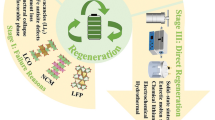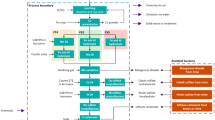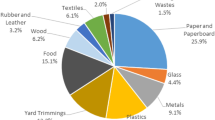Abstract
Small modular thorium-based graphite-moderated molten salt reactors (smTMSRs), which combine the advantages of small modular reactors and molten salt reactors, are regarded as a wise development path to speed deployment time. In a smTMSR, low enriched uranium and thorium fuels are used in once-through mode, which makes a marked difference in their neutronic properties compared with the case when a conventional molten salt breeder reactor is used. This study investigated the temperature reactivity coefficient (TRC) in a smTMSR, which is mainly affected by the molten salt volume fraction (VF) and the heavy nuclei concentration in the fuel salt (HN). The four-factor formula method and the reaction rate method were used to indicate the reasons for the TRC change, including the fuel density effect, the fuel Doppler effect, and the graphite thermal scattering effect. The results indicate that only the fuel density has a positive effect on the TRC in the undermoderated region. Thermal scattering from both salt and graphite has a significant negative influence on the TRC in the overmoderated region. The maximal effective multiplication factor, which shows the highest fuel utilization, is located at 10% VF and 12 mol% HN and is still located in the negative TRC region. In addition, on increasing the heavy nuclei amount from 2 mol% HN to 12 mol% HN (VF = 10%), the total TRC undergoes an obvious change from − 11 to − 3 pcm/K, which implies that the change in the HN caused by the fuel feed online should be small to avoid potential trouble in the reactivity control scheme.
















Similar content being viewed by others
References
J. Serp, M. Allibert, O. Beneš et al., The molten salt reactor (MSR) in generation IV: overview and perspectives. Prog. Nucl. Energy 77, 308–319 (2014). https://doi.org/10.1016/j.pnucene.2014.02.014
J. Krepel, B. Hombourger, V. Bykov et al., Molten salt reactor with simplified fuel recycling and delayed carrier salt cleaning, Paper Presented at the 22th International Conference on Nuclear Engineering ICONE’22, Prague, July 2014
H. Omar, K. Khattab, N. Ghazi, Feedback reactivity coefficients for the Syrian MNSR research reactor. Prog. Nucl. Energy 54(1), 162–166 (2012). https://doi.org/10.1016/j.pnucene.2011.07.001
J.E. Kelly, Generation IV international forum: a decade of progress through international cooperation. Prog. Nucl. Energy 77, 240–246 (2014). https://doi.org/10.1016/j.pnucene.2014.02.010
C.L. Brun, L. Mathieu, D. Heuer et al., Impact of the MSBR concept technology on long-lived radio-toxicity and proliferation resistance, Paper Presented at Technical Meeting on Fissile Material Management Strategies for Sustainable Nuclear Energy, Vienna, Sept 2005
L. Mathieu, D. Heuer, R. Brissot et al., The thorium molten salt reactor: moving on from the MSBR. Prog. Nucl. Energy 48(7), 664–679 (2006). https://doi.org/10.1016/j.pnucene.2006.07.005
L. Mathieu, D. Heuer, E. Merle et al., Possible configurations for the thorium molten salt reactor and advantages of the fast nonmoderated version. Nucl. Sci. Eng. 161, 78–89 (2009). https://doi.org/10.13182/NSE07-49
K. Nagy, Dynamics and fuel cycle analysis of a graphite-moderated molten salt nuclear reactor, Delft University of Technology, 2012. https://doi.org/10.4233/uuid:b4d5089d-c2de-446b-94cf-c563dd73e8f1
C.Y. Zou, X.Z. Cai, D.Z. Jiang et al., Optimization of temperature coefficient and breeding ratio for a graphite-moderated molten salt reactor. Nucl. Eng. Des. 281, 114–120 (2015). https://doi.org/10.1016/j.nucengdes.2014.11.022
D. Heuer, E. Merle-Lucotte, M. Allibert et al., Towards the thorium fuel cycle with molten salt fast reactors. Ann. Nucl. Energy 64, 421–429 (2014). https://doi.org/10.1016/j.anucene.2013.08.002
J.R. Engel, H.F. Bauman, J.F. Dearing et al., Conceptual design characteristics of a denatured molten-salt reactor with once-through fueling. Oak Ridge National Lab. ORNL/TM-7207 (1980). https://doi.org/10.2172/5352526
http://thorconpower.com/. Accessed 20 Jul 2018
L. Samalova, O. Chvala, G.I. Maldonado, Comparative economic analysis of the integral molten salt reactor and an advanced PWR using the G4-ECONS methodology. Ann. Nucl. Energy 99, 258–265 (2017). https://doi.org/10.1016/j.anucene.2016.09.001
X.Z. Cai, Z.M. Dai, H.J. Xu. Thorium molten salt reactor nuclear energy system. Phys. 9, 531–540 (2016)
G.C. Li, P. Cong, C.G. Yu et al., Optimization of Th–U fuel breeding based on a single-fluid double-zone thorium molten salt reactor. Prog. Nucl. Energy 108, 144–151 (2018)
G.C. Li, Y. Zou, C.G. Yu et al., Influences of 7Li enrichment on Th–U fuel breeding for an improved molten salt fast reactor (IMSFR). Nucl. Sci. Tech. 28, 97 (2017). https://doi.org/10.1007/s41365-017-0250-7
E. Merlelucotte, D.Heuer, M.Allibert et al. Optimization and simplification of the concept of non-moderated thorium molten salt reactor, Paper Presented at International Conference on the Physics of Reactors “Nuclear Power: A Sustainable Resource”, Casino-Kursaal Conference Center, Interlaken, 14–19 Sept 2008
B.R. Betzler, S. Robertson, E.E. Davidson et al., Assessment of the neutronic and fuel cycle performance of the transatomic power molten salt reactor design. Oak Ridge National Lab. ORNL/TM-2017/475 (2017). https://doi.org/10.2172/1410921
G.F. Zhu, Y. Zou, R. Yan, et al. Low enriched uranium and thorium fuel utilization under once-through and offline reprocessing scenarios in small modular molten salt reactor. Int. J. Energy Res. (2019). https://doi.org/10.1002/er.4676
X.-5 M.C. Team, MCNP—A general Monte Carlo N-particle transport code, Version 5. Los Alamos Nuclear Lab 2, 71–80 (2005)
D.F. Williams, Assessment of candidate molten salt coolants for the Advanced High Temperature Reactor (AHTR). Oak Ridge National Lab. ORNL/TM-2006/12 (2006). https://doi.org/10.2172/885975
F. Ganda, E. Greenspan, Analysis of reactivity coefficients of hydride-fueled PWR cores. Nucl. Sci. Eng. 164, 1–32 (2010). https://doi.org/10.13182/NSE08-64
U. Kannan, S. Ganesan, Analysis of coolant void reactivity of advanced heavy water reactor (AHWR) through isotopic reaction rates. Nucl. Sci. Eng. 167, 105–121 (2011). https://doi.org/10.13182/NSE10-17
A. Sarkar, U. Kannan and P.D. Krishnani, Energywise contributions of Th, Pu & U isotopes to the reactivity feedbacks of (Th–LEU) fuelled AHWR. Paper presented at the Thorium Energy Conference 2015 (ThEC15), Mumbai, 12–15 Oct 2015. https://doi.org/10.1007/978-981-13-2658-5_29
C.Y. Li, R.J. Sheu, J.J. Peir et al., Neutronic analyses of the HTTR core fueled with plutonium and minor actinides. Paper presented at the 2013 21st International Conference on Nuclear Engineering, 29 July–2 Aug, Chengdu, 2013. https://doi.org/10.1115/icone21-16507
C.W. Lau, C. Demazière, H. Nylén et al., Improvement of LWR thermal margins by introducing thorium. Prog. Nucl. Energy 61, 48–56 (2012). https://doi.org/10.1016/j.pnucene.2012.07.004
X.X. Li, Y.W. Ma, C.G. Yu et al., Effects of fuel salt composition on fuel salt temperature coefficient (FSTC) for an under-moderated molten salt reactor (MSR). Nucl. Sci. Technol. 29(8), 110 (2018). https://doi.org/10.1007/s41365-018-0458-1
J. Sun, Y. Zou, R. Yan et al., Analysis of the coolant reactivity coefficients of FHRs with 6Li contents of coolant. Nucl. Tech. 37(9), 090605 (2014). https://doi.org/10.11889/j.0253-3219.2014.hjs.37.090605. (in Chinese)
Z. Jitka, T. Alberto, Analysis of the reactivity coefficients of the advanced high-temperature reactor for plutonium and uranium fuels. Ann. Nucl. Energy 35(5), 904–916 (2008). https://doi.org/10.1016/j.anucene.2007.09.003
Author information
Authors and Affiliations
Corresponding authors
Additional information
This work is supported by the Chinese TMSR Strategic Pioneer Science and Technology Project (No. XDA02010000) and the Frontier Science Key Program of Chinese Academy of Sciences (No. QYZDY-SSW-JSC016).
Rights and permissions
About this article
Cite this article
Tan, ML., Zhu, GF., Zou, Y. et al. Research on the effect of the heavy nuclei amount on the temperature reactivity coefficient in a small modular molten salt reactor. NUCL SCI TECH 30, 140 (2019). https://doi.org/10.1007/s41365-019-0666-3
Received:
Revised:
Accepted:
Published:
DOI: https://doi.org/10.1007/s41365-019-0666-3




